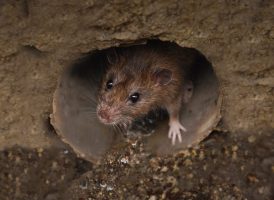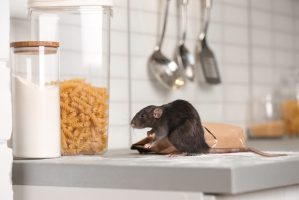Let's talk about your pest problem. Call Beaver Pest Control on 020 8355 3443 #
A-Z of Pests: Rats #
Beaver Pest Control are one of the leading expert pest control companies in the UK. Our goals are not only to provide effective pest control to our customers but also to educate everyone on the pests we deal with every day.
Why rat control is important? #
The UK rat population is thought to be in the tens of millions and growing. Rats are known carriers of a number of diseases; some of which are harmful to humans and have had a huge impact on human history such as the plague, typhus, leptospirosis and many more.
Types of rats in the UK #
There are two types of rats found in the UK:
Rattus norvegicus: The Norway, common, sewer or brown Rat
Rattus rattus: The ship, roof or black Rat.
The Brown Rat (Rattus norvegicus). This is the most common rat found in towns and cities. It has adapted to urban environments where refuse collects and uses drains and sewers which is where it gained the nickname sewer rat.
The Black Rat (Rattus rates) although once the dominant species in this country is now very rare and is usually only found in port cities.
Appearance #
When identifying rats, colour is not a reliable feature, whilst Black Rats (Rattus rattus) donned the name black rat, most have brown or greyish-reddish fur. A combination of characteristics can be used to correctly identify this pest. Black Rats tend to have larger ears and eyes then thier Brown Rat counterparts. They also hvae slender bodies and longer tails than their head and bodies. Brown rats by comparison have smaller eyes and ears, their muzzle is blunt and they are larger in size. The average weight of a Brown Rat is 250-500g whilst the Black Rat is just 100-300g.


Behavioural characteristics of rats #
Brown Rat (Rattus norvegicus)
These rats live communally and often use a system of burrows with multiple entrances and exits to move around. They will create interconnected tunnels and chambers for storing food. The Brown rats have a strong social system in which “alpha” rats will have access to better food and resources.
Black Rat (Rattus rattus)
Unlike Brown Rats, Black Rats live indoors or in high areas where their ability to climb is used to avoid humans and predators.
Mating and lifespan #
Rats can breed more efficiently than rabbits, meaning if left unchecked a single pair can develop a sizeable infestation.
Brown Rat | Black Rat | |
|---|---|---|
Sexually Mature | 12 – 16 weeks | 12 – 16weeks |
Gestation Period | 21 – 24 days | 21 – 22 days |
Litter Size (average) | 6 – 11 | 5 – 7 |
Weaning Period | 3 – 4 weeks | 3 – 4 weeks |
On average rats will live for a year in the wild. This is due to the number of predators such as stoats, weasels, foxes, dogs and predatory birds.
Signs and traces #
Due to the nocturnal nature of rats, they often go unseen. This makes it important to recognise and look out for the signs of rat infestations in order to prevent long-term problems.
Sightings are one of the obvious signs of an infestation although can’t reliably indicate how extensive the infestation is. Generally speaking, sightings during the daytime may indicate a large infestation is present.
Rats produce a characteristic stale odour that is commonly compared to the smell of ammonia. This is particularly noticeable for long-standing infestations. The smell can remain for some time after the rats have been controlled.
Dropping are a great indicator of what type of rat you are dealing with. Brown Rat droppings are on average 12mm long and are typically “spindle-shaped” or point at each end. Black rat droppings by comparison are thinner and often slightly curved and have rounded ends. They also average 9mm in length.
Fresh droppings will appear to be soft and shiny whereas, within a few days, droppings will become hard and dull.
Brown rats produce around 15ml of urine each day. They will use the urine to mark territory around the location they are nesting.
Footprints and tail swipes may be seen through fine substances such as flour, chalk or dust. Pest controllers often use luminous tracking dust to identify areas rats are most active.
Rats tend to maintain particular routes or ‘runs’. Over time these runs can develop dark-coloured smears where the rat has brushed against the surface and the grease and dirt on their fur rub off.
Brown rats will create burrows outdoors, these are easily recognised 70-120mm holes often beneath some form of cover i.e. logs, tree roots, flat stones or pavement. If indoors, they will exploit shelters in the fabric of the building such as void spaces or hollow walls.
Black rats on the other hand usually find harbourage higher up in the building using their climbing skills to remain out of reach of predators.
The biological need to gnaw for rats often gives away their presence in buildings. They will use their teeth to gain access to food and other packaged goods. They will also gnaw on the fabric of the buildings to maintain the health of their teeth which can lead to electrical fire hazards and structural damage.
Resistance #
A study from the University of Reading has revealed a new generation of rats that are showing genetic resistance to some of the common poisons used to control them.
This is not a new concept in the pest control industry. In the early 1950s first-generation anticoagulants such as Warfarin were used for the control of rats. By 1958, the first case of resistance against Brown rats was identified. In 1960, the resistance had also been identified around the Welsh border. The spread grew and was subsequently identified in Kent / Sussex and Hampshire.
This led to a search for more potent anticoagulants. In the early 1970s, second-generation anticoagulants were introduced that were proven effective against Brown rats. Resistance to these second-generation anticoagulants was identified just a few years later and has been spreading ever since.
It has been suggested that the application of rodenticides by amateurs and homeowners has accelerated this process.





